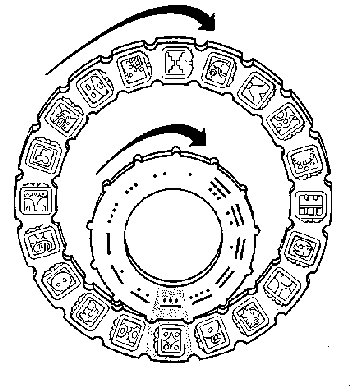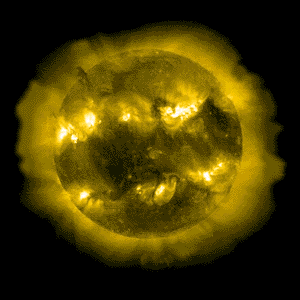First, the Mayan calendar is also sometimes called the Aztec Calendar. This calendar is recorded as a carving on the Aztec "sun stone," currently on exhibit in the National Museum of Anthropology and History located within Chapultepec Park, Mexico City. There's a lot we could say about this carved stone but most of those details are irrelevant to the "end times."
Our modern calendar, called the Gregorian Calendar, has days, weeks, months and years. In the Mayan Calendar it's more complex. In fact, it's really three calendars at the same time.
First there's a religious calendar that takes 260 days to complete a full religious cycle. There are 20 "weeks" made up of 13 days. Each week has a special name, a graphic logo and unique meaning associated with it. This reminds me of the Chinese years which cycle through "the year of the rat" and "the year of the monkey," etc., each with it's special image and meaning.
 Graphic logos for each of the 20 religious weeks.
Graphic logos for each of the 20 religious weeks.So it is possible, for any specific date, the calculate the religious week and the solar month and to predict the influences that might be guiding fate. But that's not really what's involved with the prophecy of 2012. To understand that we must look at the third calendar, called the long count.
While the first two cycles could be thought of as cogs or gears (see below) revolving through time, the long count is a linear number of days, starting from the first day, "1," and counting through each day to the present. Any day in history can be recorded using the long count and, with some simple mathematics, the corresponding religious week and solar month can also be found.
In writing this article, I thought about creating a javascript program that would do this calculation. My friend, Gene Matlock, then told me that when he was in Mexico, he found a place that sold wooden, mechanical calculators with gears that did just that. He said that Mexicans sometimes used these mechanical calendars to foretell the future or to find auspicious times for special events like marriage or births. Anyway, although it might be nice to know the religious and solar significance, it's the long count that foretells Doomsday.
 Cog or "gears" can be used to compute the religious and solar cycles for any date.
Cog or "gears" can be used to compute the religious and solar cycles for any date.The first place recorded a number from 0 to 20. To the left, the second place could have a range from 0 to 17; the third from 0 to 19; the fourth from 0 to 19 and the last from 0 to 12. The numbers were written from right to left, like our system, separated by a dot. Instead of multiples of 10, the first place had a multiple of 1 (like our system); the second place a multiple of 20; the third a multiple of 360; the fourth a multiple of 7200 and the fifth a multiple of 144000.
So a long count number, for example, could be written as 4.12.5.9.0 and would be calculated as follows:
(4 x 144000) + (12 x 7200) + (5 x 360) + (9 x 20) + (0 x 1) or a long count of 664,380.
It's not too difficult to realize that the maximum number which can be recorded this way would be 12.19.19.17.20, although some researchers like to write it as 13.0.0.0.0. This amounts to a long count number of 1,872,000 days or 5125.36 years of our modern calculations. Obviously, the calendar is very old!
Over the years, archaeologists have found carved monuments that recorded the long count for known dates in Mayan history. Once a date was fixed in time, it was easy to determine "day 1" as August 11th, 3114 BC. And it was also easy to calculate the date at which the calendar would end -- December 21st, 2012.
 Trust me, just because the calendar ends doesn't prove that time, or the world, or life will end. We need to look carefully at December 21, 2012 and try to understand why the Mayans never calculated a date beyond this point in time. To do this we must move from Archaeology to the science of Astronomy and Astrophysics.
Trust me, just because the calendar ends doesn't prove that time, or the world, or life will end. We need to look carefully at December 21, 2012 and try to understand why the Mayans never calculated a date beyond this point in time. To do this we must move from Archaeology to the science of Astronomy and Astrophysics. It's all about the Sun
It's ironic (or maybe not) that the Mayan Calendar is often called the "sun stone." While the calendar does have "solar" days, acknowledging the 365 days it takes for Earth to rotate around the Sun, it is also true that the Sun plays a key role in the final day of the "long count." To understand what will happen to the Sun on December 21, 2012, we need to review some scientific terms like "ecliptic," "barycenter," and "sunspots." These are important in the discussion that follows. We'll start with the most difficult one first.


1 comment:
I kind of wonder why there is so much interest in Mayan prophecy.
I haven't seen the movie 2012 yet, but I notice with other TV shows about end-time prophetic disasters that they leave something important out.
The Bible does say there will be end time disasters, but as I point out in my blog, the popular TV shows and books seem to leave out the fact that these disasters are coming as punishment for the sins of mankind, and are designed by a loving God to correct us and bring us to repentance, for our long-term good.
And as far as Bible prophecy is concenred, 2012 seems to be too soon for the end of this age. There are too many things that have to happen first, and I don't think 3 years is enough time. My estimate is 10 to 20 years.
Post a Comment